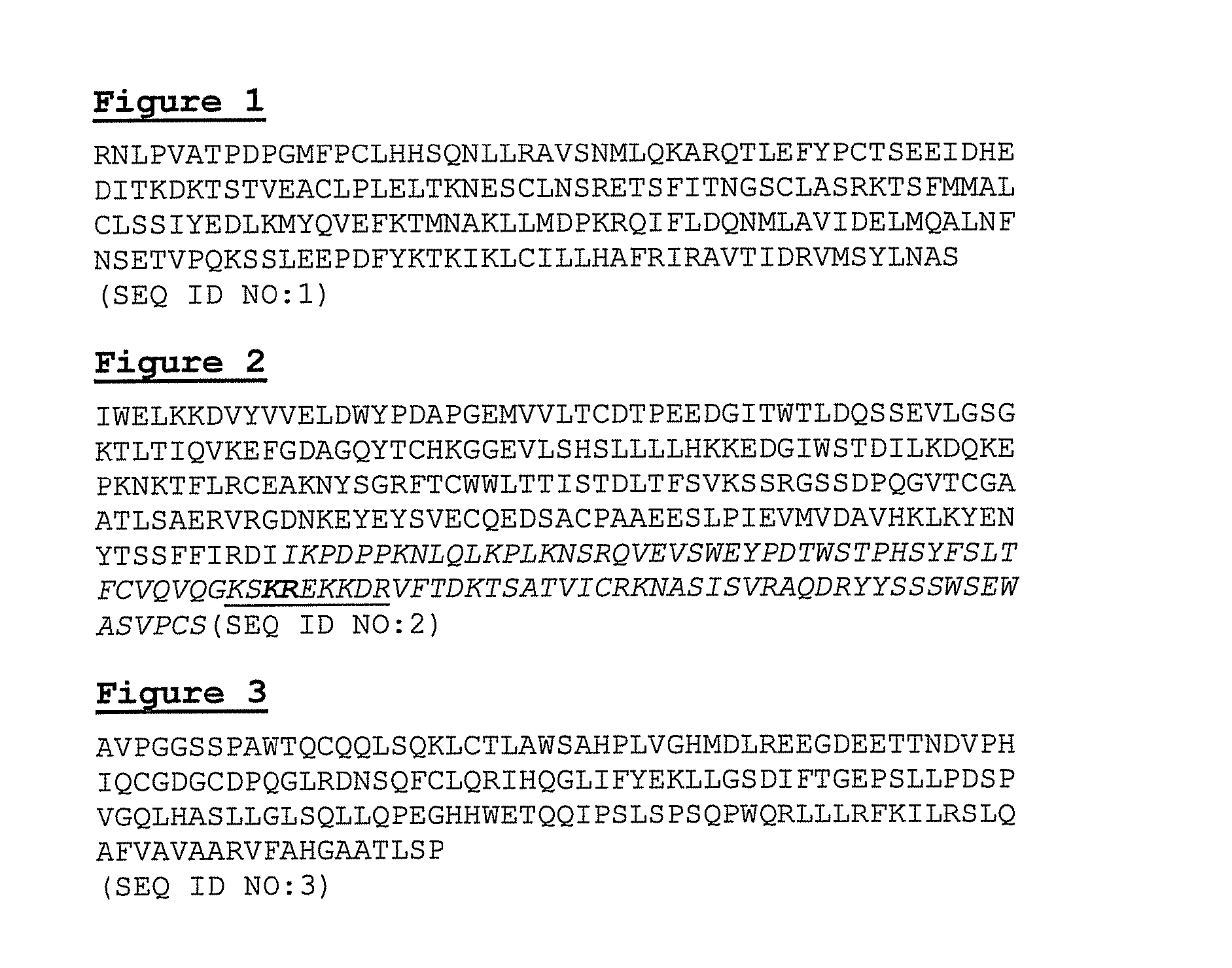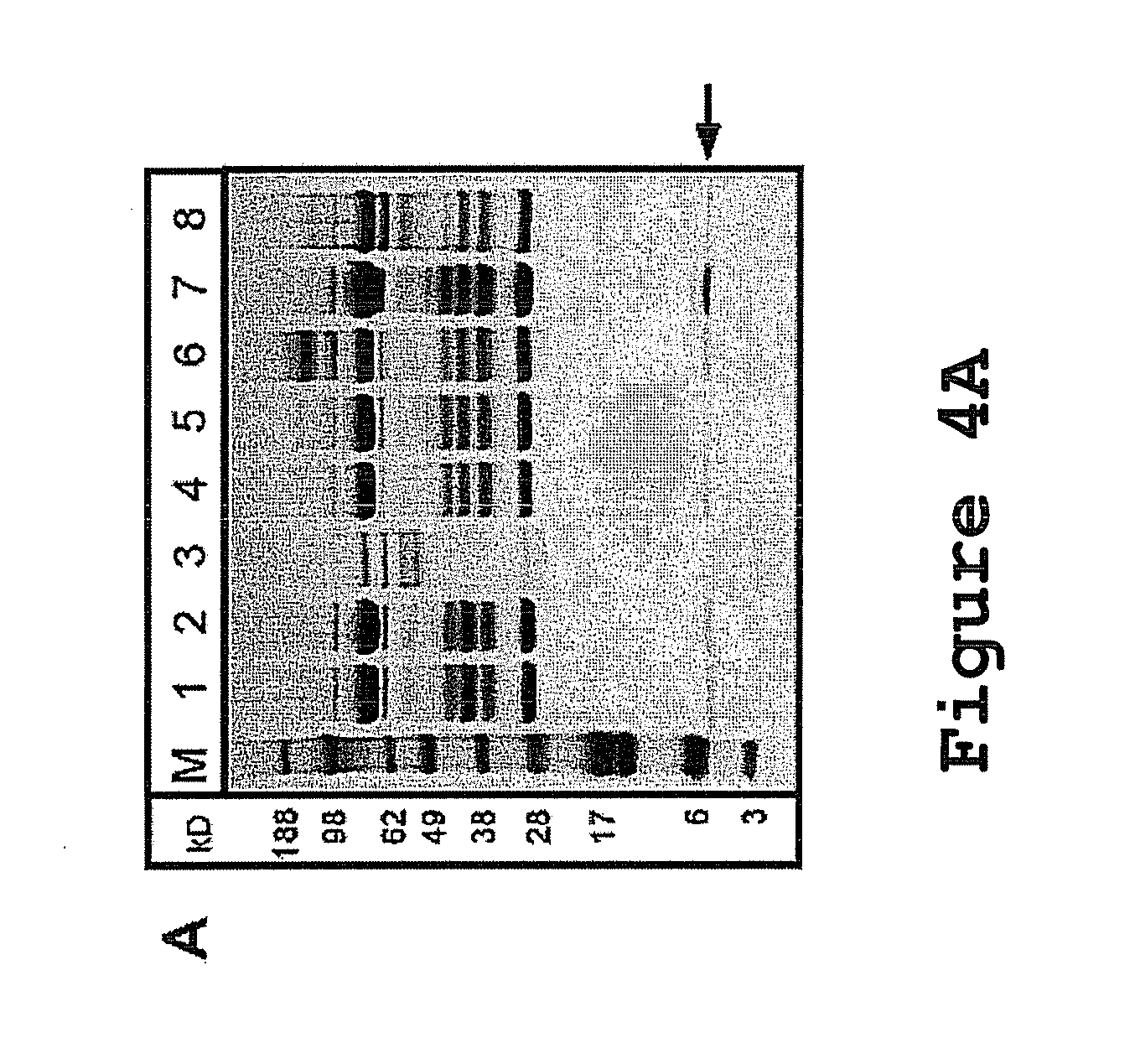Interleukin-12p40 variants with improved stability
a technology of interleukin-12p40 and stability, applied in the field of il12p40 proteins, can solve problems such as problems in its production and clinical use, and achieve the effect of improving stability and being resistant to digestion
- Summary
- Abstract
- Description
- Claims
- Application Information
AI Technical Summary
Benefits of technology
Problems solved by technology
Method used
Image
Examples
example 1
Cloning of Variants of Human IL-12p40 Subunits
Nucleic acids encoding p40 variants of the invention, in particular, p40V1 through p40V8 (SEQ ID NOS:6-13), were constructed using standard DNA techniques familiar to those skilled in the art. In essence, a DNA cassette, encoding a fragment that spans the region encompassing the mutated amino acid residues and that is bracketed by convenient restriction sites, was synthesized de novo (Blue Heron Biotechnology, Bothell, Wash.), and substituted for the corresponding fragment of wild-type sequence contained in an expression plasmid carrying the p40 sequence (see, e.g., pNC-p40 in U.S. Pat. No. 6,838,260). The nucleic acid sequence encoding mature (wild-type) human IL-12p40 subunit is shown in FIG. 19. Expression plasmids encoding the p40 variants were thus obtained.
In particular, the nucleic acids encoding p40V1 and p40V2 were generated as follows. A cloning vector carrying p40V1 and p40V2 DNA cassettes (pBHV1V2), synthesized as a contiguou...
example 2
Expression of p40 Variants and of Antibody-IL12; Fusion Proteins Containing p40 Variants
Standard methods were used to generate cell lines expressing p40 variants of the invention (see U.S. Pat. No. 6,838,260). The pNC-p40 expression plasmids encoding p40 variants were electroporated into cells, e.g., NS / 0 cells. The cells were plated, and transfected cells were selected on a G418-containing medium. Culture supernatants from drug-resistant clones were assayed for production of p40 by ELISA, and the highest producers were subcloned and tested for stable expression.
To generate antibody-IL-12 fusion protein expressing cell lines with p40 variants of the invention, the sequential transfection approach described in U.S. Pat. No. 6,838,360 was followed. For example, the fusion protein DI-NHS-IL12p40V1 was obtained by further transfecting the cell line expressing p40V1 with a second plasmid, pdHL10lambdaDI-NHS-p35, which encodes the NHS76 antibody, wherein the C-terminus of the heavy chain ...
example 3
Purification and Characterization of p40 Variants
To characterize the integrity of p40 variants p40V1, p40V2, p40V3, and p40V4 (SEQ ID NO:6-9), spent cell culture media from duplicate transiently transfected NS-0 cells expressing these variants were collected, and processed for a Western blot with a polyclonal anti-hu-p40 antibody, shown in FIG. 24. The control wild-type p40 subunit was included as a control (lane 1). It was found that the cleaved species lacking the C-terminal 6 kDa fragment, which is normally well-resolved from the intact p40 species by these electrophoretic conditions (see arrow pointing to band in lane 1), was not present in any of the variants tested (lanes 2-9), and only intact p40 could be detected. Thus, the tested p40 variants were resistant to a proteolytic activity present during protein expression.
Antibody fusion proteins containing IL-12p40 variants were purified from cell culture supernatant using standard techniques based on Protein A capture (see U.S....
PUM
 Login to View More
Login to View More Abstract
Description
Claims
Application Information
 Login to View More
Login to View More - R&D
- Intellectual Property
- Life Sciences
- Materials
- Tech Scout
- Unparalleled Data Quality
- Higher Quality Content
- 60% Fewer Hallucinations
Browse by: Latest US Patents, China's latest patents, Technical Efficacy Thesaurus, Application Domain, Technology Topic, Popular Technical Reports.
© 2025 PatSnap. All rights reserved.Legal|Privacy policy|Modern Slavery Act Transparency Statement|Sitemap|About US| Contact US: help@patsnap.com



